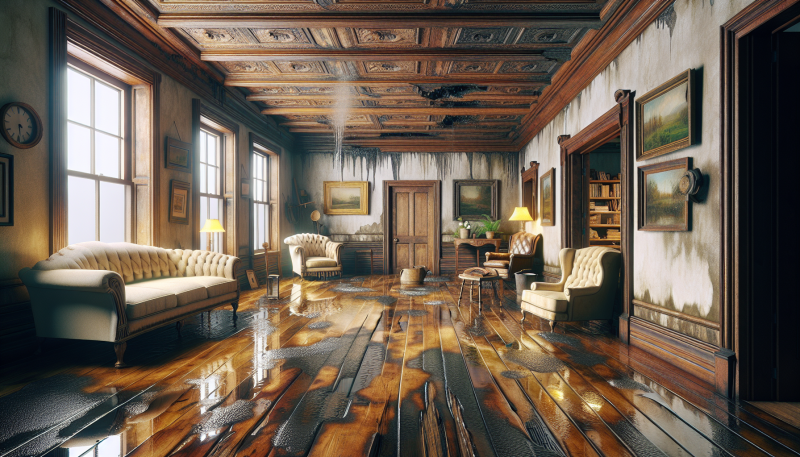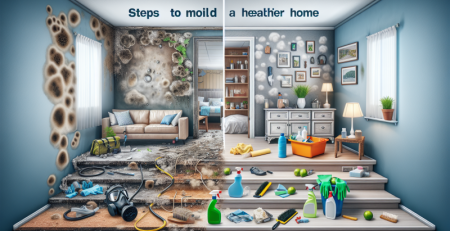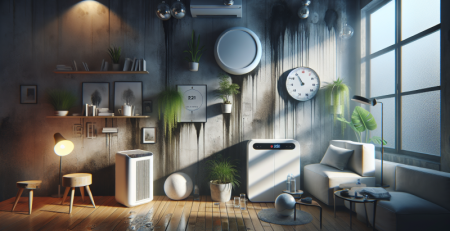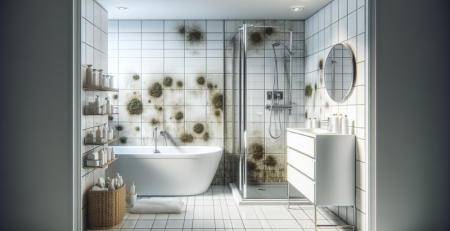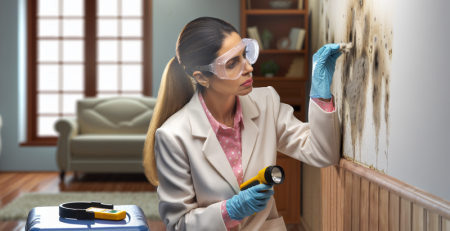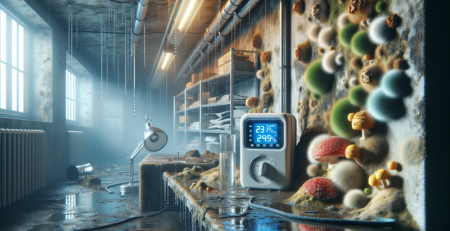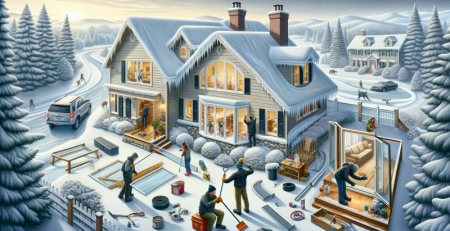How to Identify Water Damage in Older Homes
Water damage is a common yet often overlooked issue in older homes, and identifying it early can save homeowners from costly repairs and health hazards. In this guide, we will explore effective methods to spot signs of water damage, including discoloration, mold growth, and structural issues. Older homes, with their unique charm, can also harbor hidden problems like leaky roofs, outdated plumbing, and inadequate drainage systems. Understanding how to recognize these issues is crucial for maintaining the integrity of your property. At Kraus Restoration, NJ’s leaders in water, mold, and fire damage restoration, we emphasize the importance of prompt action. Our IICRC certified experts are available 24/7 to assist you with any water damage concerns. If you suspect water damage in your home, don’t hesitate to reach out to us at (973) 886-2021 for rapid response and professional support.
Understanding the Common Signs of Water Damage
Water damage is a common issue in older homes, often resulting from age-related wear and tear, plumbing failures, or environmental factors. Recognizing the signs of water damage early can save homeowners from extensive repairs and health hazards associated with mold growth. Understanding these signs is crucial for maintaining the integrity of your home and ensuring a safe living environment.
One of the most noticeable signs of water damage is discoloration on walls and ceilings. Homeowners may observe yellow or brown stains that indicate moisture accumulation. These stains often appear in areas near plumbing fixtures, roofs, or windows. If you notice any discoloration, it is essential to investigate the source of the moisture, as it could lead to more severe structural issues if left unaddressed.
Another common indicator is the presence of mold or mildew. Mold thrives in damp environments, and its growth can be a clear sign of water damage. Homeowners should be vigilant for musty odors or visible mold patches, especially in areas like basements, bathrooms, and around windows. According to the Environmental Protection Agency (EPA), mold can pose health risks, making it crucial to address any mold issues promptly. For more information on mold cleanup, you can visit our mold cleanup services page.
Peeling or bubbling paint and wallpaper is another telltale sign of water damage. When moisture seeps into walls, it can cause paint to lose its adhesion, leading to peeling or blistering. Homeowners should inspect areas where water is likely to enter, such as near windows or plumbing fixtures. If you notice these signs, it may be time to investigate further to prevent more extensive damage.
Warped or buckled flooring can also indicate water damage. Wood floors, in particular, are susceptible to moisture, which can cause them to swell and warp. Homeowners should check for any irregularities in their flooring, such as soft spots or uneven surfaces. If you suspect water damage, it is essential to address it quickly to prevent further deterioration and costly repairs.
In addition to these visible signs, homeowners should be aware of changes in their water bills. An unexplained increase in water usage can indicate a hidden leak somewhere in the plumbing system. Regularly monitoring your water bill can help you catch leaks early, preventing more significant issues down the line. If you suspect a leak, consider contacting a professional to conduct a thorough inspection.
It is also important to check for musty odors in your home. A persistent musty smell can indicate hidden mold growth or moisture problems. This odor often accompanies water damage and should not be ignored. If you detect such odors, it is advisable to investigate the source and take appropriate action.
Lastly, homeowners should be aware of their home’s foundation and exterior. Cracks in the foundation or walls can allow water to seep in, leading to significant damage over time. Regularly inspecting the exterior of your home for cracks, gaps, or signs of water pooling can help you catch potential issues early. If you notice any concerning signs, it may be beneficial to consult with a professional to assess the situation.
In summary, recognizing the common signs of water damage is essential for homeowners, especially in older homes. Discoloration, mold growth, peeling paint, warped flooring, increased water bills, musty odors, and foundation cracks are all indicators that water damage may be present. Addressing these signs promptly can prevent further damage and protect your home’s value. For more information on how to identify and address water damage, visit our water cleanup services page. Remember, early detection is key to maintaining a safe and healthy home environment. For any inquiries or to schedule an inspection, feel free to contact us.
Inspecting the Roof and Gutters for Leaks
When it comes to identifying water damage in older homes, one of the most critical areas to inspect is the roof and gutters. Over time, roofs can develop vulnerabilities due to wear and tear, weather exposure, and lack of maintenance. These vulnerabilities can lead to leaks, which are often the primary culprits behind water damage. A thorough inspection of the roof should begin with a visual assessment from the ground. Look for any obvious signs of damage, such as missing shingles, sagging areas, or discoloration. If you have access to a ladder and feel safe doing so, a closer inspection of the roof surface can reveal additional issues like cracks, rusted flashing, or accumulated debris that can trap moisture.
Gutters play a vital role in directing water away from the home. Clogged or damaged gutters can cause water to overflow and seep into the roof or walls, leading to significant water damage over time. During your inspection, check for any blockages caused by leaves, twigs, or other debris. Ensure that the gutters are securely attached and that there are no visible holes or rust spots. Downspouts should also be clear and directed away from the foundation of the home to prevent pooling water that can lead to further issues.
If you suspect that your roof or gutters may have leaks, it is advisable to conduct a more detailed inspection after a rainstorm. This can help you identify any active leaks as water may be visibly dripping or pooling in certain areas. Additionally, inspect the interior of your home for signs of water damage, such as stains on ceilings or walls, mold growth, or peeling paint. These indicators can help you pinpoint the source of the problem and determine whether it is related to the roof or gutters.
For older homes, it is essential to consider the age and condition of the roofing materials. Asphalt shingles, for example, typically last around 20 to 30 years, while metal roofs can last much longer. If your roof is nearing the end of its lifespan, it may be time to consider a replacement to prevent future leaks and water damage. Regular maintenance, such as cleaning gutters and inspecting the roof for damage, can extend the life of your roofing system and protect your home from water-related issues.
If you find evidence of leaks or significant damage during your inspection, it is crucial to address these issues promptly. Ignoring leaks can lead to more extensive damage, including structural issues and mold growth. For professional assistance, consider reaching out to experts in water damage restoration. They can provide a comprehensive assessment and recommend necessary repairs to safeguard your home. You can learn more about our water cleanup services or explore our mold cleanup services to ensure your home remains safe and dry.
In summary, inspecting the roof and gutters for leaks is a vital step in identifying water damage in older homes. Regular inspections and maintenance can help prevent minor issues from escalating into major problems. By staying proactive and addressing any signs of leaks or damage, you can protect your home and preserve its value for years to come. If you need further assistance or have questions about your home’s condition, do not hesitate to contact us for expert advice and support.
Checking for Water Stains and Mold Growth
When assessing an older home for water damage, one of the most critical steps is checking for water stains and mold growth. These indicators can reveal past or ongoing moisture issues that may compromise the integrity of the structure and the health of its occupants. Water stains typically appear as discolored patches on walls, ceilings, or floors, often taking on a yellow, brown, or dark hue. These stains can indicate leaks from plumbing, roofs, or windows, and they may be accompanied by peeling paint or wallpaper, which further suggests prolonged exposure to moisture. It is essential to inspect areas around plumbing fixtures, under sinks, and near windows and doors, as these are common sources of leaks.
In addition to visible water stains, mold growth is another significant concern. Mold thrives in damp environments and can develop within 24 to 48 hours after water exposure. It can appear in various colors, including black, green, or white, and often has a fuzzy or slimy texture. Mold can grow on a variety of surfaces, including wood, drywall, and even carpets, making it crucial to check not only visible areas but also hidden spaces such as behind appliances, inside cabinets, and in crawl spaces. If you notice a musty odor, it may indicate hidden mold growth, even if it is not immediately visible.
When inspecting for mold, it is important to consider the health implications associated with mold exposure. Mold spores can trigger allergic reactions, respiratory issues, and other health problems, particularly in sensitive individuals such as children, the elderly, or those with pre-existing health conditions. Therefore, if you discover mold, it is advisable to seek professional assistance for mold cleanup to ensure safe and effective remediation.
In older homes, the presence of water stains and mold can also indicate underlying structural issues. For instance, persistent leaks can lead to wood rot, weakened beams, and compromised foundations. It is essential to address these issues promptly to prevent further damage and costly repairs. If you suspect significant water damage, consider consulting with professionals who specialize in water damage restoration. They can provide a thorough assessment and recommend appropriate solutions to mitigate the damage.
In summary, checking for water stains and mold growth is a vital part of identifying water damage in older homes. By being vigilant and proactive in your inspection, you can protect your home and health from the adverse effects of moisture-related issues. If you encounter any signs of water damage, do not hesitate to reach out for expert help. For more information on our services or to schedule an inspection, visit our contact page.
Evaluating the Foundation and Basement for Moisture
When evaluating an older home for water damage, one of the most critical areas to inspect is the foundation and basement. These spaces are often the first to show signs of moisture intrusion, which can lead to significant structural issues and health hazards if not addressed promptly. A thorough examination of the foundation and basement can help identify potential problems before they escalate, ensuring the safety and longevity of the home.
Start by checking for visible signs of moisture on the walls and floors of the basement. Look for water stains, discoloration, or efflorescence, which is a white, powdery substance that can form on masonry surfaces when water evaporates. These indicators suggest that water has penetrated the walls, possibly due to poor drainage or cracks in the foundation. Additionally, inspect for mold growth, which thrives in damp environments and can pose serious health risks. If you notice any musty odors, this could also be a sign of hidden moisture issues.
Next, evaluate the exterior of the home. Ensure that the grading around the foundation slopes away from the house, allowing water to drain properly. Check gutters and downspouts to ensure they are functioning correctly and directing water away from the foundation. Clogged gutters can lead to overflow, causing water to pool around the base of the home, increasing the risk of moisture infiltration.
Cracks in the foundation are another critical area to assess. Small cracks may not seem alarming, but they can allow water to seep into the basement. Larger cracks or shifting in the foundation may indicate more severe structural issues that require immediate attention. If you find significant cracks or signs of settling, it may be wise to consult a professional for a comprehensive evaluation.
Additionally, consider the presence of sump pumps and drainage systems in the basement. These systems are designed to manage groundwater and prevent flooding. Ensure that they are operational and that the sump pump discharges water away from the foundation. If the home lacks a sump pump and is located in a flood-prone area, it may be necessary to install one to protect against potential water damage.
Another aspect to evaluate is the humidity levels in the basement. High humidity can lead to condensation, which contributes to mold growth and deterioration of building materials. Using a hygrometer, you can measure the humidity levels; ideally, they should be between 30 and 50 percent. If humidity levels are consistently high, consider using a dehumidifier to maintain a healthy environment.
It is also essential to inspect the plumbing in the basement. Look for any signs of leaks or corrosion on pipes, which can lead to water damage over time. Pay attention to the water heater and any appliances that may be present, as these can also be sources of moisture if they malfunction.
If you suspect that water damage has already occurred, it is crucial to address it promptly. Ignoring moisture issues can lead to more extensive damage, including structural problems and mold infestations. If you find evidence of water damage, consider contacting professionals who specialize in water cleanup and mold remediation. They can provide a thorough assessment and recommend appropriate remediation strategies to restore your home to a safe and healthy condition.
In summary, evaluating the foundation and basement for moisture is a vital step in identifying water damage in older homes. By conducting a thorough inspection, addressing any visible signs of moisture, and ensuring proper drainage and humidity control, homeowners can protect their investment and maintain a safe living environment. If you need assistance or have concerns about potential water damage, do not hesitate to reach out through our contact page for expert guidance and support.
Assessing Plumbing Systems and Fixtures
When assessing plumbing systems and fixtures in older homes, it is crucial to understand that these components can significantly contribute to water damage if they are not functioning properly. Older plumbing systems often consist of outdated materials such as galvanized steel, lead, or polybutylene, which can corrode, leak, or fail over time. Homeowners should begin by inspecting visible pipes for signs of wear, such as rust, discoloration, or moisture accumulation. Pay particular attention to joints and connections, as these areas are more susceptible to leaks. Additionally, check for any water stains on walls or ceilings, which may indicate hidden leaks from plumbing fixtures or pipes.
Fixtures such as sinks, toilets, and bathtubs should also be evaluated for functionality and integrity. Look for cracks, loose fittings, or signs of water pooling around these areas. Toilets are especially prone to issues such as leaks at the base or within the tank, which can lead to significant water loss and damage if not addressed promptly. It is advisable to test each fixture by running water and observing for any irregularities, such as slow drainage or unusual noises, which may signal underlying plumbing issues.
Another critical aspect of assessing plumbing systems is examining the water pressure. Low water pressure can indicate a blockage or leak in the system, while excessively high pressure can lead to pipe bursts and other damage. Homeowners can use a pressure gauge to measure the water pressure and determine if it falls within the acceptable range. If issues are detected, it may be necessary to consult a professional plumber who can provide a thorough inspection and recommend necessary repairs or replacements.
In addition to visible inspections, it is also essential to consider the age of the plumbing system. Many older homes may still be using original plumbing, which can be a significant risk factor for water damage. Homeowners should keep records of any plumbing work done in the past, including repairs and replacements, to better understand the current state of their plumbing system. If the plumbing is outdated, it may be worth investing in an upgrade to more modern materials that offer better durability and resistance to leaks.
Furthermore, homeowners should be aware of the potential for hidden plumbing issues that may not be immediately visible. For example, leaks can occur within walls or under floors, leading to mold growth and structural damage over time. Conducting a thorough inspection of the home’s foundation and basement can help identify any signs of water intrusion or damage. If there are concerns about mold or water damage, it may be beneficial to consult professionals who specialize in mold cleanup and water cleanup to ensure that any issues are addressed effectively.
In summary, assessing plumbing systems and fixtures in older homes is a vital step in identifying potential water damage. By conducting a thorough inspection of visible pipes and fixtures, checking water pressure, and considering the age of the plumbing system, homeowners can take proactive measures to prevent leaks and water damage. If any issues are detected, seeking the assistance of professionals can help ensure that repairs are made correctly and efficiently. For more information on how to protect your home from water damage, visit our about page or explore our services for comprehensive solutions.
The Importance of Regular Maintenance and Inspections
Regular maintenance and inspections are crucial for preserving the integrity of older homes, especially when it comes to identifying potential water damage. Older homes often come with unique challenges, including outdated plumbing, aging roofs, and deteriorating foundations, all of which can contribute to water intrusion and damage if not properly monitored. By conducting routine inspections and maintenance, homeowners can catch issues early, preventing minor problems from escalating into costly repairs.
One of the primary reasons for regular inspections is to identify signs of water damage before they become severe. Water damage can manifest in various ways, including discoloration on walls, peeling paint, warped flooring, and musty odors. These symptoms can indicate leaks or moisture buildup that, if left unchecked, can lead to structural damage and mold growth. Mold not only poses health risks but can also compromise the structural integrity of the home. Therefore, regular inspections can help homeowners detect these issues early, allowing for timely intervention.
Additionally, regular maintenance helps ensure that the home’s systems are functioning correctly. This includes checking the roof for missing shingles, inspecting gutters for clogs, and ensuring that downspouts direct water away from the foundation. A well-maintained roof and drainage system are essential for preventing water from seeping into the home. Homeowners should also inspect plumbing fixtures and appliances for leaks, as even small drips can lead to significant water damage over time. By being proactive and addressing these issues, homeowners can save themselves from the stress and financial burden associated with extensive water damage repairs.
Another important aspect of maintenance is the seasonal preparation of the home. For instance, before winter, homeowners should ensure that their heating systems are functioning properly and that pipes are insulated to prevent freezing. In the spring, it is wise to check for any water damage that may have occurred during the winter months, such as ice damming on the roof. By aligning maintenance tasks with the changing seasons, homeowners can better protect their properties from the elements.
Moreover, regular maintenance and inspections can enhance the overall value of an older home. A well-maintained property is more appealing to potential buyers and can command a higher price in the market. Buyers are often wary of homes with a history of water damage or mold issues, so demonstrating a commitment to regular upkeep can provide peace of mind and increase marketability. Homeowners should keep detailed records of all maintenance and inspections, as these documents can be beneficial during the selling process.
For those who suspect water damage or want to ensure their home is in good condition, professional inspections can be invaluable. Experts can identify hidden issues that may not be apparent to the untrained eye. They can also provide recommendations for necessary repairs and maintenance, ensuring that homeowners are well-informed about the condition of their property. Engaging professionals for water cleanup and mold cleanup services can also help mitigate damage and restore the home to a safe and healthy state.
In conclusion, regular maintenance and inspections are essential for identifying and preventing water damage in older homes. By being proactive and vigilant, homeowners can protect their investments, enhance the longevity of their properties, and ensure a safe living environment. Whether through DIY inspections or professional evaluations, taking the time to maintain an older home can lead to significant long-term benefits. For more information on how to keep your home in top condition, consider reaching out through our contact page for expert advice and services tailored to your needs.
When to Call a Professional for Help
Identifying water damage in older homes can be a daunting task, especially for homeowners who may not be familiar with the signs and implications of such issues. While some minor water damage can be addressed with DIY solutions, there are instances when it is crucial to call a professional for help. Understanding when to seek expert assistance can save you time, money, and further damage to your property.
If you notice persistent dampness or water stains on walls, ceilings, or floors, it is essential to take these signs seriously. While a small stain might seem manageable, it could indicate a more significant underlying issue, such as a leaky roof or plumbing problem. In such cases, a professional can conduct a thorough inspection to determine the source of the moisture and recommend appropriate solutions. Their expertise can help prevent further deterioration of your home and ensure that any repairs are done correctly.
Another critical factor to consider is the presence of mold. Mold can develop rapidly in areas affected by water damage, particularly in older homes where ventilation may be inadequate. If you see mold growth or experience musty odors, it is advisable to contact a professional mold remediation service. Mold not only poses health risks but can also lead to structural damage if not addressed promptly. Professionals have the necessary tools and knowledge to safely remove mold and prevent its return.
If you have experienced significant water intrusion, such as from a flood or burst pipe, it is vital to call in experts immediately. Water damage restoration professionals can assess the extent of the damage, extract standing water, and implement drying techniques to mitigate further issues. They can also help with the restoration process, ensuring that your home is safe and habitable again. Attempting to handle extensive water damage on your own can lead to incomplete repairs and lingering problems, such as structural instability or ongoing mold growth.
Additionally, if you are unsure about the extent of the damage or how to proceed, seeking professional help is always a wise choice. Experts in water damage restoration can provide you with a comprehensive evaluation and guide you through the necessary steps to restore your home. They can also assist with insurance claims, ensuring that you receive the coverage you need for repairs.
In summary, while some water damage issues in older homes can be managed independently, there are clear indicators that signal the need for professional intervention. Persistent dampness, mold growth, significant water intrusion, and uncertainty about the damage’s extent are all valid reasons to reach out to experts. By doing so, you can protect your home, your health, and your investment. For more information on how to address water damage, consider visiting our water cleanup services or explore our mold cleanup services. If you have any questions or need assistance, feel free to contact us for expert guidance.
In conclusion, identifying water damage in older homes is crucial for maintaining the integrity and safety of your living space. By being vigilant and familiarizing yourself with the common signs of water damage—such as discoloration on walls, musty odors, warped flooring, and visible mold—you can take proactive steps to address issues before they escalate. Regular inspections, especially in areas prone to moisture, such as basements, attics, and around plumbing fixtures, can help you catch problems early. Additionally, understanding the unique vulnerabilities of older homes, such as outdated plumbing and roofing, will empower you to make informed decisions about repairs and renovations. If you suspect water damage, don’t hesitate to consult a professional for a thorough assessment. By staying proactive and informed, you can protect your home’s value and ensure a safe, healthy environment for you and your family. Remember, a little vigilance today can save you from costly repairs tomorrow.
